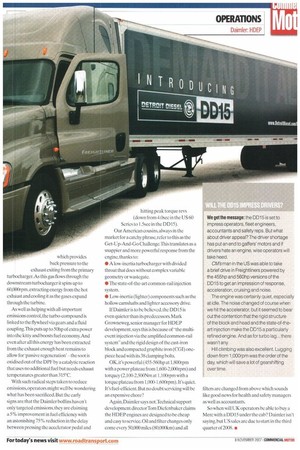SAY HELLO TO THE NEXT GENERATION
Page 62

Page 63

If you've noticed an error in this article please click here to report it so we can fix it.
Daimler's HDEP engine family is being developed to meet forthcoming emission standards in Europe and Japan as well as the US. It has taken five years and over 1 bn to
develop; Steve Sturgess finds out more.
Daimler's Heavy Duty Engine Platform (HDEP) offers a fascinating insight into the technology that will feature in the next generation of trucks. It represents the latest advances in the evolution of the diesel engine — as it should, coming at the end of a five-year development programme that cost the company more than fibn ('New Mercedes engine makes debut in the US', CM 25 October). So what has Daimler achieved for its money? Primarily, emissions controls that will eventually take Mercedes to Euro-6 (scheduled for 2012) and beyond. High fuel injection pressure makes for cleaner combustion and the 14.8-litre D1315. which is aimed at the European market ,features a common-rail system fed by a two-stage pump. In its first stage pressure rises to 900bar,it is then raised to a rail pressure of 2,100bar. Each electronically controlled squirt of diesel into the combustion chamber has multiple pulses to allow precise control of its rate and `shape'.This cuts nitrogen oxide (N0x) generation,while reducing the diesel knock in the cylinders.
The DD15 relies on cooled exhaust gas recirculation (EGR) to further reduce NOx emission, but that doesn't mean that the EGR vs SCR debate is over — the chances are that going to Euro-6 and beyond will entail a combination of both these rival technologies.
Particulate matter (PM) emissions are soaked up by a diesel particulate filter (DPF) developed for the latest US-spec Series 60 engine (which will also be superseded by the HDER albeit a 15.6-litre variant).
Turbo-compounding and EGR
Turlx)-compound technology is an established way of capturing more of the energy that is otherwise wasted in the exhaust by using exhaust gases to drive two turbochargers rather than one. But in this case the turbocompounding is also key to the EGR flow which provides back pressure to the exhaust exiting from the primary turbocharger. As this gas flows through the downstream turbocharger it spins up to 60,000rpm, extracting energy from the hot exhaust and cooling it as the gases expand through the turbine.
As well as helping with all-important emissions control, the turbo-compound is linked to the flywheel via gears and a fluid wupling.This puts up to 50hp of extra power into the kitty and boosts fuel economy. And even after all this energy has been extracted from the exhaust enough heat remains to allow for 'passive regeneration' the soot is oxidised out of the DPF by a catalytic reaction that uses no additional fuel but needs exhaust temperatures greater than 315`r.
With such radical steps taken to reduce emissions, operators might well be wondering what has been sacrificed. But the early signs are that the Daimler boffins haven't only targeted emissions, they are claiming a 5% improvement in fuel efficiency with an astonishing 75% reduction in the delay between pressing the accelerator pedal and hitting peak torque revs (down from 4.0sec in the US 60 Series to I .5see in the DD15).
Our American cousins, always in the market for a catchy phrase,refer to this as the Get-Up-And-Go Challenge. This translates as a snappier and more powerful response from the engine, thanks to: • A low-inertia turbocharger with divided throat that does without complex variable geometry or wastegate.
• The state-of-the-art common-rail injection system.
• Low-inertia (lighter) components such as the hollow camshafts and lighter accessory drive.
If Daimler is to be believed. the DD15 is even quieter than its predecessors Mark Growneweg, senior manager for HDEP development, says this is because of the multievent injection via the amplified common-rail systemand the rigid design of the cast-iron block and compacted graphite iron (CGI) onepiece head with its 38 clamping bolts OK,it's powerful (455-560hp at 1,800rpm with a power plateau from 1,600-2,000rpm) and torquey (2,100-2,500Nm atl AM-pm with a torque plateau from 1,000-1,600rpm). It's quiet. It's fuel-efficient. But no doubt servicing will be an expensive chore?
Again, Daintier says not.Technical support development directorTom Diefenbaker claims the HDEP engines are designed to be cheap and easy to service. Oil and filter changes only come every 50,000 miles (80,000Iun) and all filters are changed from above which sounds like good news for health and safety managers as well as accountants.
So when will UK operators be able to buy a Mere with a DD15 under the cab? Daimler isn't saying, hut US sales are due to start in the third quarter of 2008. •






















































































































































































